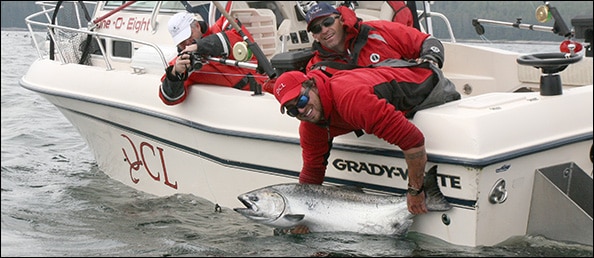Tugcapitan
Well-Known Member
The Haida Gwaii fishing report thread developed an interesting argument about whether released fish will live to spawn.
Obviously handling techniques, or a lack there of will be a huge factor.
Someone posted a photo of a 52 lb chinook in post 1, and of course it got jumped on by those supporting the "let the big girls go" ...
A good point was brought up that if it was an epic battle fought to the end, that fish might die if you release it, and since your going to fill your license on a Charlottes trip, now you've killed 2 fish instead of one with the 20 lber you took after to "replace it"
Someone else said they have "studies" saying many of these released fish live.
Personally, I'm skeptical that anyone could know the survival rate of released fish. Way too many variables to consider, and how could you possibly monitor the released fish to the spawning grounds in great enough numbers to be a meaningful study?
I agree with the post that stated a long and epic battle with hooks in its mouth is going to lessen a chinooks chances of survival.
Then again, their strong survival instinct is plain to see on fish with sea lion or orca scars, or as you watch them beat themselves to a pulp jumping up the Rivers.
I've bonked fish over 50lbs, I've let ones close to that go. Loved both.
I think common sense at the side of the boat will help you determine whether or not that particular fish will live... But, will it?
Also, if you haven't been a guide, please don't bash guides for not "talking their guests into releasing the big ones" You know who you are, you don't know what it's like. Each different fish and guest will determine the proper course of action to take.
I do agree that releasing big fish is a noble pursuit.... Too bad for them that bonking them is also such a thrill...
Obviously handling techniques, or a lack there of will be a huge factor.
Someone posted a photo of a 52 lb chinook in post 1, and of course it got jumped on by those supporting the "let the big girls go" ...
A good point was brought up that if it was an epic battle fought to the end, that fish might die if you release it, and since your going to fill your license on a Charlottes trip, now you've killed 2 fish instead of one with the 20 lber you took after to "replace it"
Someone else said they have "studies" saying many of these released fish live.
Personally, I'm skeptical that anyone could know the survival rate of released fish. Way too many variables to consider, and how could you possibly monitor the released fish to the spawning grounds in great enough numbers to be a meaningful study?
I agree with the post that stated a long and epic battle with hooks in its mouth is going to lessen a chinooks chances of survival.
Then again, their strong survival instinct is plain to see on fish with sea lion or orca scars, or as you watch them beat themselves to a pulp jumping up the Rivers.
I've bonked fish over 50lbs, I've let ones close to that go. Loved both.
I think common sense at the side of the boat will help you determine whether or not that particular fish will live... But, will it?
Also, if you haven't been a guide, please don't bash guides for not "talking their guests into releasing the big ones" You know who you are, you don't know what it's like. Each different fish and guest will determine the proper course of action to take.
I do agree that releasing big fish is a noble pursuit.... Too bad for them that bonking them is also such a thrill...



